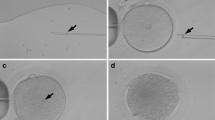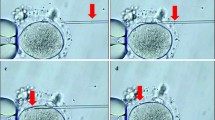Abstract
Objective
Our purpose was to reduce oocyte damage before clinical application of intracytoplasmic single sperm injection by training on aged unfertilized oocytes.
Design
Intracytoplasmic single sperm injection (ICSI) was accomplished by micromanipulation of sperm and oocytes.
Patients
Thirty-four patients consented to donate unfertilized aged oocytes to train for ICSI. Forty-four patients suffering from severe male infertility were treated with ICSI.
Intervention
Oocytes were inseminated by intracytoplasmic single sperm injection.
Main outcome measures
Oocyte damage and fertilization and pregnancy rates were the outcome measures.
Results
One hundred fifty-one aged unfertilized oocytes were gathered for training of which 121 were injected with a single sperm and 30 without a spermatozoon as a control group for activation. Oocyte damage, initially as high as 40%, was reduced to 15% after 60 oocytes. Normal fertilization (2PN) occurred in 18%, and polyploidy in 4.4%. The cleavage rate was 69%; none of these embryos were transferred. In the control group, seven oocytes were damaged, seven (30%) showed one pronucleus, and one showed two pronuclei. No cleavage was observed in the control group. In the clinical trial, 44 patients (61 cycles) were clinically treated with the same ICSI procedure, including 575 of 721 collected oocytes. Damage was 13%, activation was 11%, normal fertilization was 30%, and 5 (1%) polypoid zygotes were observed. The fertilization rate ranged from 5 to 100%, with a mean of 39.5±4% (SE). Nine patients had no fertilization (15%). Ninetysix percent of the zygotes cleaved and 47% were at the four-cell stage 45 hr after injection. One hundred twelve embryos were replaced in 48 transfers (2.3 embryos/ET). One live birth, one miscarriage, and eight ongoing pregnancies were obtained (22%/ET).
Conclusion
Preclinical practice on aged unfertilized oocytes seems useful before starting clinical ICSI, as the high initial oocyte damage can be reduced and subsequent clinical treatment successfully applied.
Similar content being viewed by others
References
Ng S, Bongso A, Ratnam SS, Sathananthan H, Chang CLK, Wong PC,et al.: Pregnancy after transfer of sperm under zona (letter). Lancet 1988;332:790
Ng S, Bongso A, Chang S, Sathananthan H, Ratnam S: Transfer of human sperm into the perivitelline space of human oocytes after zona-drilling or zona puncture. Fertil Steril 1989;52:73–78
Fishel S, Antinori S, Jackson P, Johnson J, Lisi F, Chiariello F,et al.: Twin birth after subzonal insemination. Lancet 1990;335:722–723
Bertrand E, Van den Bergh M, Englert Y: Assessment of one year SUZI procedure (submitted)
Lanzendorf S, Maloney M, Veeck L, Slusser J, Hodgen G, Rosenwaks Z: A preclinical evaluation of pronuclear formation by microinjection of human spermatozoa into human oocytes. Fertil Steril 1988;49:835–842
Palermo G, Joris H, Devroey P, Van Steirteghem AC: Pregnancies after intracytoplasmic injection of single spermatozoon into an oocyte. Lancet 1992;340:17–18
Palermo G, Joris H, Derde MP, Camus M, Devroey P, Van Steirteghem AC: Sperm characteristics and outcome of human assisted fertilization by subzonal insemination and intracytoplasmic sperm injection. Fertil Steril 1993;59:826–835
Palermo G, Van Steirteghem AC: Enhancement of acrosome reaction and subzonal insemination of a single spermatozoon in mouse eggs. Mol Reprod Dev 1991;30:339–345
Barg P, Wahrman M, Talansky B, Gordon J: Capacitated, acrosome reacted but immotile sperm, when microinjected under the mouse zona pellucida, will not fertilize the oocyte. J Exp Zool 1986;237:365–374
Yanagida K, Yanagimachi R, Perreault S, Kleinfeld R: Thermostability of sperm nuclei assessed by microinjection into hamster oocytes. Biol Reprod 1991;44:440–447
Odawara Y, Lopata A: A zona opening procedure for improving in vitro fertilization at low sperm concentrations: A mouse model. Fertil Steril 1989;51:699–704
Ogura A, Yanagimachi R: Round spermatid nuclei injected into hamster oocytes form pronuclei and participate in syngamy. Biol Reprod 1993;48:219–225
Tesarik J: The potential diagnostic use of human zona free eggs prepared from oocytes that failed to fertilize in vitro. Fertil Steril 1989;52:821–824
Tesarik J: Subzonal sperm insertion with aged human oocytes from failed in vitro fertilization attempts: Fertilization results and some applications. Hum Reprod 1993;10:1245–1250
Wiker S, Tucker M, Wright G, Malter H, Kort H, Massey J: Repeated sperm injection under the zona following initial fertilization failure. Hum Reprod 1993;8:467–469
Morrol DR, Critchlow JD, Matson PL, Lieberman BA: The use of cryopreserved aged human oocytes in a test of the fertilizing capacity of human spermatozoa. Hum Reprod 1992;7:671–676
Englert Y, Van den Bergh M, Rodesch C, Vandervorst P, Berberoglugil P, Laruelle C, Biramane J, Gervy C, Schwers J: Nouveau programme de fécondation in vitro à l'hopital Erasme: Premiers résultats et aspects originaux. Rev Med Brux 1991;12:305–314
Englert Y, Van den Bergh M, Rodesch C, Bertrand E, Biramane J, Legreve A: Comparative auto-controlled study between swim-up and Percoll preparation of fresh semen samples for in-vitro-fertilization. Hum Reprod 1992;7:399–402
Puissant F, Van Rysselberge M, Barlow P, Deweze J, Leroy F: Embryo scoring as a prognostic toll in IVF treatment. Hum Reprod 1987;2:705–708
Ben-Rafael Z, Kopf G, Blasco L, Tureck R, Mastroianni L: Fertilization and cleavage after reinsemination of human oocytes in vitro. Fertil Steril 1986;45:58–62
Trounson A, Webb J: Fertilization of human oocytes following reinsemination in vitro. Fertil Steril 1984;41:816–819
Pampiglione J, Mills C, Campbell S, Steer C, Kingsland C, Mason B: The clinical outcome of reinsemination of human oocytes fertilized in vitro. Fertil Steril 1990;53:306–310
Barlow P, Englert Y, Puissant F, Lejeune B, Delvigne A, Van Rysselberge A, Leroy F: Fertilization failure in IVF: Why and what next? Hum Reprod 1990;5:451–456
First International Advanced Course in Assisted Fertilization by Intracytoplasmic Sperm Injection. ESHRE Campus workshop. Brussels: Centre for Reproductive Medicine Brussels Dutch-Speaking Free University Hospital, 1993
Uehara T, Yanagimachi R: Activation of hamster eggs by pricking. J Exp Zool 1977;199:269
Author information
Authors and Affiliations
Rights and permissions
About this article
Cite this article
Van Den Bergh, M., Bertrand, E. & Englert, Y. Intracytoplasmic single sperm injection: preclinical training and first clinical results. J Assist Reprod Genet 11, 289–294 (1994). https://doi.org/10.1007/BF02215715
Received:
Accepted:
Issue Date:
DOI: https://doi.org/10.1007/BF02215715




